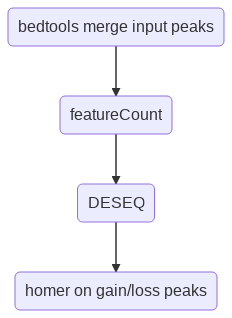DESEQ2 for differential peak analysis¶
usage: diffPeak.py [-h] [-b BAMS] [-d DESIGN_MATRIX] [-p PEAKS] [-x DRY_RUN]
[-z SUBMIT_JOB] [-r FLAG] [--include_unmapped_reads] [-s]
[-j JID]
optional arguments:
-h, --help show this help message and exit
-b BAMS, --bams BAMS list of bam files (include path to file)
-d DESIGN_MATRIX, --design_matrix DESIGN_MATRIX
Each line is a group. Every group will be compared
against the 'control' group. So you have to specify a
control group in your input. The format for each line
is: group_id:file_name_1,file_name_2. Just need file
name, no need for the path to file.
-p PEAKS, --peaks PEAKS
list of narrowPeak files (include path to file), need
the last line to be empty (i.e. so as to have the
newline character).
-x DRY_RUN, --dry_run DRY_RUN
1 or 0. 1: dry run, to check system commands
-z SUBMIT_JOB, --submit_job SUBMIT_JOB
1 or 0. 1: submit this job to HPC
-r FLAG, --flag FLAG 1 or 0. 1: run this job in terminal. 0: submit this
job.
--include_unmapped_reads
Expecting global change, need normalization by total
reads
-s, --single run featureCount in single-end mode
-j JID, --jid JID enter a job ID, which is used to make a new directory.
Every output will be moved into this folder.
Summary¶
This program performs differential peak analysis by taking the union of input peaks (i.e., bedtools merge), counting number of reads (for pair-end, it is number of fragments), then running DESEQ2. At the last step, peaks will be divided into gain or loss, each of which will be used to perform motif discovery using homer. The files *loss.bed and *gain.bed are not full list of differential peaks, these are just top 100 peaks used for motif discovery. Users can open *diffRegions.txt to extract their own diff peaks based on q-value and logFC.
Note
By default, DESEQ2 normalization is performed on total reads in peaks. You can also do it on raw total reads (i.e., sequencing depth), by using --include_unmapped_reads.
Flowchart¶

Usage¶
hpcf_interactive
module load python/2.7.12
dos2unix bams.list
dos2unix design_matrix
dos2unix peaks.list
diffPeak.py -b bams.list -d design_matrix -p peaks.list -z 1
``-z 1 `` tells the program to submit this job to HPC. Otherwise, diffPeak will just run interactively.
If you want to include all reads for DESEQ normalization, please add --include_unmapped_reads option. Note that this option tends to give a little less significant p-value and logFC.
If you are using single-end bam, please add -s option.
Input¶
Sample input examples are shown here: https://benchling.com/s/etr-FHkOZSXjFTUTDROQ2xu2
Input file syntax:
File names are separated by comma. No space bettwen them.
For design matrix, the first line
controlis a keyword. All the remaining lines will be compared to thecontrolline.Leave the last line blank.
Output¶
Gain and Loss is relative speaking to control. So gain means the region has more reads in treatment and less reads in control group, so is logFC > 0.
Read count table is generated in DEseq2_results folder
DESEQ2 result (
control-[user_input_group].diffRegions.txt) is generated in homer_motifs folder. In this file,logFC < 0 means gain, the peak has less read count in control group.. In all other files (e.g., values in bdg_files folder) are corrected.
Apply LFC shrinkage¶
Users can use the generated count table count_table.bed and run the DESEQ2 analysis themself. An example to apply LFC shrinkage is here: DEseq2_example
FAQ¶
No significant differential peaks, too many adj pvalues = 1¶
P-value calculated is based on mean and variance. If there are no significant results, it means that the estimated dispersion (i.e., variance) is large enough to decrease the significance. This could be due to many reasons. You can try the following (ranked by likelihood):
Low number of replicates.
How we normalize the reads: try with or without this option.
--include_unmapped_readstry to identify outliers
try different number of peaks. (MACS2, by varying its p-value threshold, you can get different number of peaks)
data quality
It is a fact that there is truly no difference.
Notes¶
When the logFC is similar (e.g., logFC=1), EdgeR quasi-likelihood test tend to have more significant p-value.
Ref¶
https://support.bioconductor.org/p/95949/
https://www.biostars.org/p/251411/